MIMO-OTFS in High-Doppler Fading Channels: Signal Detection and
Channel Estimation
M. Kollengode Ramachandran and A. Chockalingam
Department of ECE, Indian Institute of Science, Bangalore 560012
8
1
0
2
y
a
M
6
]
T
I
.
s
c
[
1
v
9
0
2
2
0
.
5
0
8
1
:
v
i
X
r
a
Abstract—Orthogonal time frequency space (OTFS) modula-
tion is a recently introduced multiplexing technique designed in
the 2-dimensional (2D) delay-Doppler domain suited for high-
Doppler fading channels. OTFS converts a doubly-dispersive
channel into an almost non-fading channel in the delay-Doppler
domain through a series of 2D transformations. In this paper,
we focus on MIMO-OTFS which brings in the high spectral
and energy efficiency benefits of MIMO and the robustness
of OTFS in high-Doppler fading channels. The OTFS channel-
symbol coupling and the sparse delay-Doppler channel impulse
response enable efficient MIMO channel estimation in high
Doppler environments. We present an iterative algorithm for sig-
nal detection based on message passing and a channel estimation
scheme in the delay-Doppler domain suited for MIMO-OTFS.
The proposed channel estimation scheme uses impulses in the
delay-Doppler domain as pilots for estimation. We also compare
the performance of MIMO-OTFS with that of MIMO-OFDM
under high Doppler scenarios.
keywords: OTFS modulation, MIMO-OTFS, 2D modulation, delay-
Doppler domain, MIMO-OTFS signal detection, channel estimation.
I. INTRODUCTION
Future wireless systems including 5G systems need to
operate in dynamic channel conditions, where operation in
high mobility scenarios (e.g., high-speed trains) and millimeter
wave (mm Wave) bands are envisioned. The wireless chan-
nels in such scenarios are doubly-dispersive, where multipath
propagation effects cause time dispersion and Doppler shifts
cause frequency dispersion [1]. OFDM systems are usually
employed to mitigate the effect of inter-symbol interference
(ISI) caused by time dispersion [2]. However, Doppler shifts
result in inter-carrier interference (ICI) in OFDM and degrades
performance [3]. An approach to jointly combat ISI and
ICI is to use pulse shaped OFDM systems [4]-[6]. Pulse
shaped OFDM systems use general time-frequency lattices
and optimized pulse shapes in the time-frequency domain.
However, systems that employ the pulse shaping approach do
not efficiently address the need to support high Doppler shifts.
Orthogonal time frequency space (OTFS) modulation is a
recently proposed multiplexing scheme [7]-[10] which meets
the high-Doppler signaling need through a different approach,
namely, multiplexing the modulation symbols in the delay-
Doppler domain (instead of multiplexing symbols in time-
frequency domain as in traditional modulation techniques such
as OFDM). OTFS waveform has been shown to be resilient
to delay-Doppler shifts in the wireless channel. For example,
OTFS has been shown to achieve significantly better error
performance compared to OFDM for vehicle speeds ranging
from 30 km/h to 500 km/h in 4 GHz band, and that the
robustness to high-Doppler channels (e.g., 500 km/h vehicle
speeds) is especially notable, as OFDM performance breaks
down in such high-Doppler scenarios [9]. When OTFS wave-
form is viewed in the delay-Doppler domain, it corresponds
to a 2D localized pulse. Modulation symbols, such as QAM
symbols, are multiplexed using these pulses as basis functions.
The idea is to transform the time-varying multipath channel
into a 2D time-invariant channel in the delay-Doppler domain.
This results in a simple and symmetric coupling between the
channel and the modulation symbols, due to which significant
performance gains compared to other multiplexing techniques
are achieved [7]. OTFS modulation can be architected over any
multicarrier modulation by adding pre-processing and post-
processing blocks. This is very attractive from an implemen-
tation view-point.
Recognizing the promise of OTFS in future wireless sys-
tems, including mmWave communication systems [10], several
works on OTFS have started emerging in the recent literature
[11]-[16]. These works have addressed the formulation of
input-output relation in vectorized form, equalization and de-
tection, and channel estimation. Multiple-input multiple-output
(MIMO) techniques along with OTFS (MIMO-OTFS) can
achieve increased spectral/energy efficiencies and robustness
in rapidly varying MIMO channels. It is shown in [7] that
OTFS approaches channel capacity through linear scaling of
spectral efficiency with the MIMO order. We, in this paper,
consider the signal detection and channel estimation aspects
in MIMO-OTFS.
Our contributions can be summarized as follows. We first
present a vectorized input-output formulation for the MIMO-
OTFS system. Initially, we assume perfect channel knowl-
edge at the receiver and employ an iterative algorithm based
on message passing for signal detection. The algorithm has
low complexity and it achieves very good performance. For
example, in a 2 × 2 MIMO-OTFS system, a bit error rate
(BER) of 10−5 is achieved at an SNR of about 14 dB for a
Doppler of 1880 Hz (500 km/hr speed at 4 GHz). For the
same system, MIMO-OFDM BER performance floors at a
BER of 0.02. Next, we relax the perfect channel estimation
assumption and present a channel estimation scheme in the
delay-Doppler domain. The proposed scheme uses impulses in
the delay-Doppler domain as pilots for MIMO-OTFS channel
estimation. The proposed scheme is simple and effective in
high-Doppler MIMO channels. For example, compared to the
case of perfect channel knowledge, the proposed scheme loses
�
Delay-Doppler domain (OTFS modulation)
OTFS transform
OTFS inverse transform
x[k; l]
ISFFT &
transmit
windowing
X[n; m]
Heisenberg
transform
x(t)
y(t)
Channel
h(τ; ν)
Wigner
transform
Y [n; m]
Receive
windowing
& SFFT
^x[k; l]
Pre-processing
Time-Frequency Domain (TF modulation)
Post-processing
Fig. 1. OTFS modulation scheme.
performance only by less than a fraction of a dB.
The rest of the paper is organized as follows. The OTFS
modulation is introduced in Sec. II. The MIMO-OTFS system
model and the vectorized input-output relation are developed
in Sec. III. MIMO-OTFS signal detection using message
passing and the resulting BER performance are presented in
Sec. IV. The channel estimation scheme in the delay-Doppler
domain and the achieved performance are presented in Sec.
V. Conclusions are presented in Sec. VI.
II. OTFS MODULATION
OTFS modulation uses the delay-Doppler domain for mul-
tiplexing the modulation symbols and for channel represen-
tation. When the channel impulse response is represented in
the delay-Doppler domain, the received signal y(t) is the sum
of reflected copies of the transmitted signal x(t), which are
delayed in time (τ ), shifted in frequency (ν), and multiplied
by the complex gain h(τ, ν) [8]. Thus, the coupling between
an input signal and the channel in this domain is given by the
following double integral:
Let Wtx[n, m] and Wrx[n, m] denote the transmit and receive
windows, respectively.
A. Time-frequency modulation
• Let ϕtx(t) and ϕrx(t) denote the transmit and receive
pulses, respectively, which are bi-orthogonal with respect
to time and frequency translations. Signal
in the TF
domain X[n, m], n = 0, · · · , N − 1, m = 0, · · · , M − 1
is transmitted in a given packet burst.
• TF modulation/Heisenberg transform: The signal in the
time-frequency domain X[n, m] is transformed to the
time domain signal x(t) using the Heisenberg transform
given by
x(t) =
N −1
Xn=0
M −1
Xm=0
X[n, m]ϕtx(t−nT )ej2πm∆f (t−nT ). (2)
• TF demodulation/Wigner transform: At the receiver, the
time domain signal is transformed back to the TF domain
using Wigner transform given by
h(τ, ν)x(t − τ )ej2πν(t−τ )dτ dν.
(1)
Y [n, m] = Aϕrx,y(τ, ν)|τ =nT,ν=m∆f ,
(3)
y(t) =ZνZτ
The block diagram of the OTFS modulation scheme is shown
in Fig. 1. The inner box is the familiar time-frequency multi-
carrier modulation, and the outer box with a pre- and post-
processor implements the OTFS modulation scheme in the
delay-Doppler domain. The information symbols x[k, l] (e.g.,
QAM symbols) residing in the delay-Doppler domain are first
transformed to the familiar time-frequency (TF) domain signal
X[n, m]
through the 2D inverse symplectic finite Fourier
transform (ISFFT) and windowing. The Heisenberg transform
is then applied to the TF signal X[n, m] to transform to the
time domain signal x(t) for transmission. At the receiver,
the received signal y(t) is transformed back to a TF domain
signal Y [n, m] through Wigner transform (inverse Heisenberg
transform). Y [n, m] thus obtained is transformed to the delay-
Doppler domain signal y[k, l] through the symplectic finite
Fourier transform (SFFT) for demodulation.
In the following subsections, we describe the signal models
in TF modulation and OTFS modulation. Let T denote the
TF modulation symbol time and ∆f denote the subcarrier
spacing. Let x[k, l], k = 0, · · · , N − 1, l = 0, · · · , M − 1 be
the information symbols transmitted in a given packet burst.
where Aϕrx,y(τ, ν) is the cross ambiguity function given
by
Aϕrx,y(τ, ν) =Z ϕ∗
rx(t − τ )y(t)e−j2πν(t−τ )dt,
(4)
and y(t) is related to x(t) by (1). The relation between Y [n, m]
and X[n, m] for TF modulation can be derived as [9]
Y [n, m] = H[n, m]X[n, m] + V [n, m],
(5)
where V [n, m]
H[n, m] is given by
is the additive white Gaussian noise and
H[n, m] =ZτZν
h(τ, ν)ej2πνnT e−j2π(ν+m∆f )τ dνdτ.
(6)
B. OTFS modulation
• Let Xp[n, m] be the periodized version of X[n, m] with
period (N, M ). The SFFT of Xp[n, m] is given by
xp[k, l] =
N −1
Xn=0
M −1
Xm=0
Xp[n, m]e−j2π( nk
N − ml
M ),
(7)
�
and the ISFFT is Xp[n, m] = SF F T −1(x[k, l]), given by
Xp[n, m] =
1
M N
N −1
M −1
Xk=0
Xl=0
x[k, l]ej2π( nk
N − ml
M ).
(8)
• Information symbols x[k, l], k = 0, · · · , N − 1, l =
0, · · · , M − 1, are transmitted in a given packet burst.
• OTFS transform/pre-processing: The information sym-
bols in the delay-Doppler domain x[k, l] are mapped to
TF domain symbols X[n, m] as
Assume that the windows used in modulation, Wtx[n, m] and
M∆f and νi = βi
Wrx[n, m] are rectangular. Define τi = αi
N T ,
where αi and βi are integers denoting the indices of the delay
tap (with delay τi) and Doppler tap (with Doppler value νi). In
practice, although the delay and Doppler values are not exactly
integer multiples of the taps, they can be well approximated by
a few delay-Doppler taps in the discrete domain [19]. With the
above assumptions, the input-output relation for the channel
in (16) can be derived as [12]
X[n, m] = Wtx[n, m]SF F T −1(x[k, l]),
(9)
y[k, l] =
h′
ix[((k − βi))N , ((l − αi))M )] + v[k, l].
(17)
P
Xi=1
where h′
sented in vectorized form as [12]
i = hie−j2πνiτi . The above equation can be repre-
y = Hx + v,
(18)
where x, y, v ∈ CN M ×1, H ∈ CN M ×N M , the (k + N l)th
element of x, xk+N l = x[k, l], k = 0, · · · , N − 1, l =
0, · · · , M −1, and the same relation holds for y and z as well.
In this representation, there are only P non-zero elements in
each row and column of the equivalent channel matrix (H)
due to modulo operations.
III. MIMO-OTFS MODULATION
Consider a MIMO-OTFS system as shown in Fig. 2 with
equal number of transmit (nt) and receive antennas (nr), i.e.,
nt = nr = na. Each antenna transmits OTFS modulated in-
formation symbols independently. Let the windows Wtx[n, m],
Wrx[n, m] used for modulation be rectangular. Assume that
the channel corresponding to pth transmit antenna and qth
receive antenna has P taps as in (16). Therefore, the channel
representation can be written as
hqp(τ, ν) =
hqpi δ(τ − τi)δ(ν − νi),
(19)
P
Xi=1
A. Vectorized formulation of
MIMO-OTFS
the input-output relation for
Let Hqp denote the equivalent channel matrix corresponding
to pth transmit antenna and qth receive antenna. Let xp denote
the N M ×1 transmit vector from the pth transmit antenna and
yq denote the N M × 1 received vector corresponding to qth
receive antenna in a given frame. Then, similar to the system
model in (18) for a SISO-OTFS, we can derive a linear system
model describing the input and output for the MIMO-OTFS
system as given below
y1 = H11x1 + H12x2 + · · · + H1na xna + v1,
y2 = H21x1 + H22x2 + · · · + H2na xna + v2,
...
yna = Hna1x1 + Hna2x2 + · · · + Hnana xna + vna . (20)
where Wtx[n, m]
summable function.
is the transmit windowing square
• X[n, m] thus obtained is in the TF domain and it is TF
modulated as described in the previous subsection, and
Y [n, m] is obtained by (3).
• OTFS demodulation/post-processing: A receive window
Wrx[n, m] is applied to Y [n, m] and periodized to obtain
Yp[n, m] which has the period (N, M ), as
YW [n, m] = Wrx[n, m]Y [n, m],
Yp[n, m] =
∞
Xk,l=−∞
YW [n − kN, m − lM ]. (10)
The symplectic finite Fourier transform is then applied
to Yp[n, m] to convert it from TF domain back to delay-
Doppler domain ˆx[k, l], as
ˆx[k, l] = SF F T (Yp[n, m]).
(11)
The input-output relation in OTFS modulation can be derived
as [9]
ˆx[k, l] =
1
M N
where
hw k − n
N T
,
,
M −1
N −1
N T
x[n, m]hw k − n
Xn=0
Xm=0
M ∆f = hw(ν′, τ ′)|ν ′= k−n
l − m
l − m
M ∆f+ v[k, l],
(12)
where hw(ν′, τ ′) is the circular convolution of the channel
response with a windowing function w(τ, ν), given by
hw(ν′, τ ′) =ZνZτ
where w(τ, ν) is given by
h(τ, ν)w(ν′ − ν, τ ′ − τ )dτ dν,
(14)
w(τ, ν) =
M −1
Xm=0
N −1
Xn=0
Wtx[n, m]Wrx[n, m]e−j2π(νnT −τ m∆f ).
(15)
C. Vectorized formulation of the input-output relation
Consider a channel with P signal propagation paths (taps).
Let the path i be associated with a delay τi, a Doppler νi,
and a fade coefficient hi. The channel impulse response in the
delay-Doppler domain can be written as
h(τ, ν) =
P
Xi=1
hiδ(τ − τi)δ(ν − νi).
(16)
N T ,τ ′= l−m
M ∆f
,
(13)
p = 1, 2, · · · , na, q = 1, 2, · · · , na. Thus, we can use the
vectorized formulation in Sec. II-C for each transmit and
receive antenna pair to describe the input-output relation.
�
x1(k; l)
X1[n; m]
Pre-processing
Heisenberg
transform
x1(t)
h11(τ; ν)
h21(τ; ν) h12(τ; ν)
y1(t)
Wigner
transform
Y1[n; m]
^x1[k; l]
Post-processing
x2(k; l)
X2[n; m]
Pre-processing
Heisenberg
transform
x2(t)
h1na (τ; ν)
hna 1(τ; ν)
y2(t)
Wigner
transform
Y2[n; m]
^x2[k; l]
Post-processing
xna (k; l)
Xna [n; m]
Pre-processing
Heisenberg
transform
xna (t)
yna (t)
Wigner
transform
Yna [n; m]
^xna [k; l]
Post-processing
Fig. 2. MIMO-OTFS modulation scheme.
Define
HMIMO =
H11 H12
H21 H22
...
...
Hna1 Hna2
. . . H1na
. . . H2na
. . .
. . . Hnana
...
,
xMIMO = [x1
vMIMO = [v1
T , x2
T , v2
T , · · · , xna
T , · · · , vna
T ]
T ]
T
T
Then, (20) can be written as
, yMIMO = [y1
T , y2
T , · · · , yna
T
T ]
,
.
yMIMO = HMIMOxMIMO + vMIMO,
(21)
CnaN M ×1, HMIMO
∈
where xMIMO, yMIMO, vMIMO
CnaN M ×naN M . Thus,
representation, each row
and column of HMIMO has only naP non-zero elements due to
modulo operations.
∈
in this
IV. MIMO-OTFS SIGNAL DETECTION
In this section, we present a MIMO-OTFS signal detection
scheme using an iterative algorithm based on message passing
and present a performance comparison between MIMO-OTFS
and MIMO-OFDM in high-Doppler scenarios.
A. Algorithm for MIMO-OTFS signal detection
Let the sets of non-zero positions in the bth row and ath
column of HMIMO be denoted by ζb and ζa, respectively. Using
(21), the system can be modeled as a sparsely connected factor
graph with naN M variable nodes corresponding to the ele-
ments in xMIMO and naN M observation nodes corresponding to
the elements in yMIMO. Each observation node yb is connected to
the set of variable nodes {xc, c ∈ ζb}, and each variable node
xa is connected to the set of observation nodes {yc, c ∈ ζa}.
Also, |ζb| = |ζa| = naP . The maximum a posteriori (MAP)
decision rule for (21) is given by
ˆxMIMO = argmax
Pr(xMIMO|yMIMO, HMIMO),
(22)
xMIMO∈AnaN M
where A is the modulation alphabet (e.g., QAM) used. The
detection as per (22) has exponential complexity. Hence, we
use symbol by symbol MAP rule for 0 ≤ a ≤ naN M − 1 for
detection as follows:
ˆxa = argmax
Pr(xa = aj|yMIMO, HMIMO)
aj ∈A
= argmax
aj ∈A
1
|A|
Pr(yMIMO|xa = aj, HMIMO)
≈ argmax
aj ∈A Yc∈ζa
Pr(yc|xa = aj, HMIMO).
The transmitted symbols are assumed to be equally likely and
the components f yMIMO are nearly independent for a given
xa due to the sparsity in HMIMO. This can be solved using
the message passing based algorithm described below. The
message that is passed from the variable node xa, for each
a = {0, 1, · · · , naN M − 1}, to the observation node yb for
b ∈ ζa, is the pmf denoted by pab = {pab(aj)|aj ∈ A} of the
symbols in the constellation A. Let Hab denote the element
in the ath row and bth column of HMIMO. The message passing
algorithm is described as follows.
1: Inputs: yMIMO, HMIMO, Niter: max. number of iterations.
2: Initialization:
Iteration index t = 0, pmf p(0)
ab =
1/|A| ∀ a ∈ {0, 1, · · · , naN M − 1} and b ∈ ζa.
3: Messages from yb to xa: The mean (µ(t)
ba ) and vari-
ance ((σ(t)
ba )2) of the interference term Iba are passed as
messages from yb to xa. Iba can be approximated as a
Gaussian random variable and is given by
Iba = Xc∈ζb ,c6=a
xcHb,c + vb.
(23)
The mean and variance of Iba are given by
|A|
µ(t)
ba = E[Iba] = Xc∈ζb,c6=a
Xj=1
p(t)
cb (aj)ajHb,c,
(σ(t)
ba )2 = Var[Iba]
= Xc∈ζb
c6=a
|A|
Xj=1
p(t)
cb (aj)|aj |2|Hb,c|2 −
|A|
Xj=1
p(t)
2!
cb (aj)ajHb,c
+ σ2.
�
4: Messages from xa to yb: Messages passed from variable
(t+1)
ab
nodes xa to observation nodes yb is the pmf vector p
with the elements given by
p(t+1)
ab = ∆ p(t)
ab (aj ) + (1 − ∆) p(t−1)
ab
(aj),
(24)
where ∆ ∈ (0, 1] is the damping factor for improving
convergence rate, and
p(t)
ab ∝ Yc∈ζa,c6=b
where
Pr(yc|xa = aj, HMIMO),
(25)
Pr(yc|xa = aj, HMIMO) ∝ exp −|yc − µ(t)
ca − Hc,aaj|2
σ2(t)
c,a
!.
5: Stopping
|p(t+1)
criterion: Repeat
(aj) − p(t)
till
ab (aj)| < ǫ (where ǫ is a small
max
a,b,aj
value) or the maximum number of iterations, Niter, is
reached.
3 & 4
steps
ab
6: Output: Output the detected symbol as
ˆxa = argmax
pa(aj), a ∈ 0, 1, 2, · · · , naN M − 1, (26)
aj ∈A
where
pa(aj ) = Yc∈ζa
Pr(yc|xa = aj, HMIMO).
(27)
B. Vectorized formulation of
MIMO-OFDM
the input-output relation for
In this subsection, in order to provide a performance com-
parison between MIMO-OTFS and MIMO-OFDM, we present
the vectorized formulation of the input-output relation for
MIMO-OFDM. OFDM uses the TF domain for signaling and
channel representation. We will first derive the vectorized
formulation for a SISO-OFDM and extend it
to MIMO-
OFDM. For a fair comparison with the OTFS modulation, we
will consider N consecutive OFDM blocks (each of size M )
to be one frame, i.e., the transmit vector xOFDM ∈ CN M ×1, and
message passing detection is done jointly over one N M × 1
frame. Consider the channel in (16). The time-delay repre-
sentation h(τ, t) is related to the delay-Doppler representation
h(τ, ν) by a Fourier transform along the time axis, and is given
by
h(τ, t) =
hiej2πνitδ(τ − τi).
(28)
Sample the time axis at t = nT s = n
delay representation h(τ, n) is given by
M∆f . The sampled time-
h(τ, n) =
hie
j2πνi n
M ∆f δ(τ − τi).
(29)
P
Xi=1
P
Xi=1
Let CP = P − 1 denote the cyclic prefix length used in each
OFDM block and let L = M + CP . The size of one frame
after cyclic prefix insertion to each block will then be N L.
Let TCP = [CT
denote the L × M matrix that inserts
cyclic prefix for one block, where CCP contains the last CP
CP IM ]
T
|
|
{z
N times
N times
{z
{z
}
rows of the identity matrix IM . Also, let RCP = [0M ×CP IM ]
denote the M × L the matrix that removes the cyclic prefix
for one block [18]. Let WM ×M and WH
M ×M denote the DFT
and IDFT matrices of size M . We use the following notations.
: cyclic prefix
• Bcpin = diag (TCP , TCP , · · · , TCP )
insertion matrix for N consecutive OFDM blocks.
• Bcpre = diag (RCP , RCP , · · · , RCP )
: cyclic prefix
removal matrix for N consecutive OFDM blocks.
• D = diag (W, W, · · · , W)
: DFT matrix for N consec-
}
}
|
|
utive OFDM blocks.
N times
• DH = diag (WH , WH , · · · , WH )
: IDFT matrix for N
N times
consecutive OFDM blocks.
{z
}
• The channel in the time-delay domain for a given frame
can be written as a matrix Htd using (29) and has size
N L × N L.
Using the above, the end-to-end relationship in OFDM mod-
ulation can be described by the following linear model:
yOFDM = DBcpreHtdBcpinDH
xOFDM + v
|
HOFDM
{z
= HOFDMxOFDM + v,
}
(30)
where xOFDM, yOFDM, v ∈ CN M ×1, HOFDM ∈ CN M ×N M .
1) MIMO-OFDM: The vectorized formulation of the input-
output relation for SISO-OFDM derived above can be ex-
tended to MIMO-OFDM in a similar fashion as was done for
the MIMO-OTFS system described in Sec. III-A. Let HOFDMqp
denote the equivalent channel matrix corresponding to pth
transmit antenna and qth receive antenna. Let xOFDMp denote
the N M ×1 transmit vector from the pth transmit antenna and
yOFDMq denote the N M × 1 received vector corresponding to
qth receive antenna in a given frame. Define
HMIMO-OFDM =
HOFDM11 HOFDM12
HOFDM21 HOFDM22
...
...
HOFDMna 1 HOFDMna 2
. . . HOFDM1na
. . . HOFDM2na
. . .
. . . HOFDMna na
...
,
xMIMO-OFDM = [xOFDM1
yMIMO-OFDM = [yOFDM1
T , xOFDM2
T , yOFDM2
T , · · · , xOFDMna
T , · · · , yOFDMna
T
T ]
T
T ]
,
.
The input-output relation for MIMO-OFDM can be written as
yMIMO-OFDM = HMIMO-OFDMxMIMO-OFDM + vMIMO-OFDM,
(31)
where xMIMO-OFDM, yMIMO-OFDM, vMIMO-OFDM
HMIMO-OFDM ∈ CnaN M ×naN M .
∈ CnaN M ×1
and
C. Performance results and discussions
In this subsection, we present the BER performance of
MIMO-OTFS and compare it with that of MIMO-OFDM.
Perfect channel knowledge is assumed at the receiver. Message
�
Path index (i)
Delay (τi), µs
Doppler (νi), Hz
1
2.08
0
2
4.164
470
3
6.246
940
4
8.328
1410
5
10.41
1880
DELAY-DOPPLER PROFILE FOR THE CHANNEL MODEL WITH P = 5.
TABLE I
Parameter
Carrier frequency (GHz)
Subcarrier spacing (kHz)
Frame size (M, N )
Modulation scheme
MIMO configuration
Maximum speed (kmph)
Value
4
15
(32, 32)
BPSK
1×1, 2×2, 3×3
507.6
TABLE II
SYSTEM PARAMETERS.
passing algorithm is used for both MIMO-OTFS and MIMO-
OFDM. A damping factor of 0.5 is used. The maximum
number of iterations and the ǫ value used are 30 and 0.01,
respectively. We use the channel model in (19) and the number
of taps P is taken to be 5. The delay-Doppler profile consid-
ered in the simulation is shown in Table I. Other simulation
parameters used are given in Table II.
Figure 3 shows the BER performance of MIMO-OTFS for
SISO as well as 2 × 2 and 3 × 3 MIMO configurations.
The maximum considered speed of 507.6 kmph corresponds
to 1880 Hz Doppler frequency at a carrier frequency of 4
GHz. Even at this high-Doppler value, MIMO-OTFS is found
to achieve very good BER performance. We observe that,
a BER of 10−5 is achieved at an SNR of about 14 dB
for the 2×2 system, while the SNR required to achieve the
same BER reduces by about 2 dB for the 3×3 system. Thus,
with the proposed detection algorithm, MIMO-OTFS brings
in the advantages of linear increase in spectral efficiency with
number of transmit antennas and the robustness of OTFS
modulation in high-Doppler scenarios.
Figure 4 shows the BER performance comparison between
MIMO-OTFS and MIMO-OFDM in a 2 × 2 MIMO system.
The maximum Doppler spread in the considered system is high
(1880 Hz) which causes severe ICI in the TF domain. Because
of the severe ICI, the performance of MIMO-OFDM is found
100
10-1
10-2
10-3
10-4
10-5
10-6
0
2
4
6
8
10
12
14
Fig. 4. BER performance comparison between MIMO-OTFS and MIMO-
OFDM in a 2 × 2 MIMO system.
to break down and floor at a BER value of about 2 × 10−2.
However, MIMO-OTFS is able to achieve a BER of 10−5
at an SNR value of about 14 dB. This is because OTFS uses
the delay-Doppler domain for signaling instead of TF domain.
Thus, the BER plots clearly illustrate the robust performance
of MIMO-OTFS and its superiority over MIMO-OFDM under
rapidly varying channel conditions.
V. CHANNEL ESTIMATION FOR MIMO-OTFS
In this section, we relax the assumption of perfect channel
knowledge and present a channel estimation scheme in the
delay-Doppler domain. The scheme uses impulses in the delay-
Doppler domain as pilots. Figure 5 gives an illustration of the
pilots, channel response, and received signal in a 2 × 1 MIMO
system with the delay-Doppler profile and system parameters
given in Tables I and II. Each transmit and receive antenna
pair sees a different channel having a finite support in the
delay-Doppler domain. The support is determined by the delay
and Doppler spread of the channel [8]. This fact can be used
to estimate the channel for all the transmit-receive antenna
pairs simultaneously using a single MIMO-OTFS frame as
described below.
The OTFS input-output relation for pth transmit antenna and
qth receive antenna pair can be written using (12) as
100
10-1
10-2
10-3
10-4
10-5
10-6
0
ˆxq[k, l] =
M −1
N−1
Xm=0
Xn=0
xp[n, m]
1
M N
hwqp k − n
N T
,
If we transmit
l − m
M ∆f+vq[k, l].
(32)
xp[n, m] = 1 if (n, m) = (np, mp)
= 0 ∀ (n, m) 6= (np, mp),
(33)
as pilot from the pth antenna, the received signal at the qth
antenna will be
We can estimate
being the pilots, np and mp are known at the receiver a
N T ,
(34)
l − mp
M ∆f + vq[k, l].
M∆f from (34), since,
l
2
4
6
8
10
12
14
ˆxq[k, l] =
1
M N
,
N T
hwqp k − np
M N hwqp k
1
Fig. 3. BER performance of MIMO-OTFS for SISO, and 2 × 2 and 3 × 3
MIMO systems.
�
Fig. 5.
Illustration of pilots and channel response in delay-Doppler domain in a 2×1 MIMO-OTFS system.
priori. From this, we can get the equivalent channel matrix
ˆHqp using the vectorized formulation of Sec. II-C. From
(34) we also see that, due to the 2D-convolution input-output
relation, the impulse at (n, m) = (np, mp) is spread by the
channel only to the extent of the support of the channel in the
delay-Doppler domain. Thus, if we send the pilot impulses
from the transmit antennas with sufficient spacing in the
delay-Doppler domain, they will be received without overlap.
Hence, we can estimate the channel responses corresponding
to all the transmit-receive antenna pairs simultaneously and get
the estimate of the equivalent MIMO-OTFS channel matrix
ˆHMIMO using a single MIMO-OTFS frame. This is illustrated
in Fig. 5 for a 2 × 1 MIMO-OTFS system with frame size
(M, N ) = (32, 32) at an SNR value of 4 dB. The first antenna
transmits the pilot impulse at (n1, m1) = (0, 0) and the second
antenna transmits the pilot impulse at (n2, m2) = (16, 16) in
the delay-Doppler domain. We observe that the impulse re-
N T , l−m2
M∆f are non-
sponse hw11 k−n1
N T , l−m1
the receiver. Thus,
M∆f and hw12 k−n2
overlapping at
simultaneously using a single pilot MIMO-OTFS frame.
they can be estimated
12
10
8
6
4
2
0
0
2
4
6
8
10
12
14
Fig. 6. Frobenius norm of the difference between the equivalent channel
matrix (HMIMO) and the estimated equivalent channel matrix ( ˆHMIMO) as a
function of pilot SNR in a 2×2 MIMO-OTFS system.
A. Performance results and discussions
In this subsection, we present the BER performance of the
MIMO-OTFS system using the estimated channel. We use the
MIMO-OTFS channel estimation scheme described above, for
estimating the equivalent channel matrix ˆHMIMO and use the
message passing algorithm for detection. The delay-Doppler
profile and the simulation parameters are as given in Table I
and Table II, respectively.
In Fig. 6, we plot the Frobenius norm of the difference
between the equivalent channel matrix (HMIMO) and the es-
timated equivalent channel matrix ( ˆHMIMO) (a measure of
estimation error) as a function of pilot SNR for a 2 × 2
MIMO-OTFS system with system parameters as in Tables
I and II. We observe that, as expected, the Frobenius norm
of the difference matrix decreases with pilot SNR. Figure 7
shows the corresponding BER performance using the proposed
channel estimation scheme for the 2 × 2 MIMO-OTFS system.
It is observed that the BER performance achieved with the
estimated channel
is quite close to the performance with
perfect channel knowledge. For example, a BER of 2 × 10−5
is achieved at SNR values of about 12.5 dB and 13 dB with
perfect channel knowledge and estimated channel knowledge,
respectively. At the considered maximum Doppler frequency
of 1880 Hz, channel estimation in the time-frequency domain
leads to inaccurate estimation because of the rapid variations
of the channel in time. On the other hand, the sparse channel
representation in the delay-Doppler domain is time-invariant
over a larger observation time. This, along with the OTFS
channel-symbol coupling (2D periodic convolution) in the
delay-Doppler domain, enables the proposed channel estima-
tion for MIMO-OTFS to be simple and efficient.
�
[9] R. Hadani, S. Rakib, M. Tsatsanis, A. Monk, A. J. Goldsmith, A. F.
Molisch, and R. Calderbank, “Orthogonal time frequency space modula-
tion,” Proc. IEEE WCNC’2017, pp. 1-7, Mar. 2017.
[10] R. Hadani, S. Rakib, A. F. Molisch, C. Ibars, A. Monk, M. Tsatsanis, J.
Delfeld, A. Goldsmith, and R. Calderbank, “Orthogonal time frequency
space (OTFS) modulation for millimeter-wave communications systems,”
in Proc. IEEE MTT-S Intl. Microwave Symp., pp. 681-683, Jun. 2017.
[11] L. Li, H. Wei, Y. Huang, Y. Yao, W. Ling, G. Chen, P. Li, and
Y. Cai, “A simple two-stage equalizer with simplified orthogonal time
frequency space modulation over rapidly time-varying channels,” online:
arXiv:1709.02505v1 [cs.IT] 8 Sep 2017.
[12] P. Raviteja, K. T. Phan, Q. Jin, Y. Hong, and E. Viterbo, “Low-
complexity iterative detection for orthogonal time frequency space mod-
ulation,” online: arXiv:1709.09402v1 [cs.IT] 27 Sep 2017.
[13] A. R. Reyhani, A. Farhang, M. Ji, R-R. Chen, and B. Farhang-
Boroujeny, “Analysis of discrete-time MIMO OFDM-based orthogonal
time frequency space modulation,” arXiv:1710.07900v1 [cs.IT] 22 Oct
2017.
[14] T. Dean, M. Chowdhury, and A. Goldsmith, “A new modulation tech-
nique for Doppler compensation in frequency-dispersive channels,” Proc.
IEEE PIMRC’2017, Oct. 2017.
[15] A. Farhang, A. Rezazadeh Reyhani, L. E. Doyle, and B. Farhang-
Boroujeny, “Low complexity modem structure for OFDM-based orthog-
onal time frequency space modulation,” IEEE Wireless Commun. Lett.,
doi: 10.1109/LWC.2017.2776942, Nov. 2017.
[16] K. R. Murali and A. Chockalingam, “On OTFS modulation for high-
Doppler fading channels,” Proc. ITA’2018, San Diego, Feb. 2018.
[17] Y.G. Li, J.H. Winters, and N.R. Sollenberger, “MIMO-OFDM for wire-
less comunications: signal detection with enhanced channel estimation,”
IEEE Trans. Commun., vol. 50, no. 9, pp. 1471-1477, Sep. 2002.
[18] F. Hlawatsch and G. Matz, Wireless Communications Over Rapidly
Time-Varying Channels, Academic Press, 2011.
[19] A. Fish, S. Gurevich, R. Hadani, A. M. Sayeed, and O. Schwartz,
“Delay-Doppler channel estimation in almost linear complexity,” IEEE
Trans. Inf. Theory, vol. 59, no. 11, pp. 7632-7644, Nov. 2013.
100
10-1
10-2
10-3
10-4
10-5
10-6
0
2
4
6
8
10
12
14
Fig. 7. BER performance of MIMO-OTFS system using the estimated channel
in a 2×2 MIMO-OTFS system.
VI. CONCLUSIONS
We investigated signal detection and channel estimation
aspects of MIMO-OTFS under high-Doppler channel condi-
tions. We developed a vectorized formulation of the input-
output relationship for MIMO-OTFS which enables MIMO-
OTFS signal detection. We presented a low complexity itera-
tive algorithm for MIMO-OTFS detection based on message
passing. The algorithm was shown to achieve very good BER
performance even at high Doppler frequencies (e.g., 1880 Hz)
in a 2 × 2 MIMO system where MIMO-OFDM was shown
to floor in its BER performance. We also presented a channel
estimation scheme in the delay-Doppler domain, where delay-
Doppler impulses are used as pilots. The proposed channel
estimation scheme was shown to be efficient and the BER
degradation was small as compared to the performance with
perfect channel knowledge. The sparse nature of the channel in
the delay-Doppler domain which is time-invariant over a larger
observation time enabled the proposed estimation scheme to
be simple and efficient.
REFERENCES
[1] W. C. Jakes, Microwave Mobile Communications, New York: IEEE Press,
reprinted, 1994.
[2] A. Goldsmith, Wireless Communications, Cambridge Univ. press, 2005.
[3] T. Wang, J. G. Proakis, E. Masry, and J. R. Zeidler, “Performance
degradation of OFDM systems due to Doppler spreading,” IEEE Trans.
Wireless Commun., vol. 5, no. 6, pp. 1422-1432, Jun. 2006.
[4] T. Strohmer and S. Beaver, “Optimal OFDM design for time-frequency
dispersive channels,” IEEE Trans. Commun., vol. 51, no. 7, pp. 1111-
1122, Jul. 2003.
[5] F-M. Han and X-D. Zhang, “Hexagonal multicarrier modulation: a
robust transmission scheme for time-frequency dispersive channels,” IEEE
Trans. Signal Process., vol. 55, no. 5, pp. 1955-1961, May 2007.
[6] F-M. Han and X-D. Zhang, “Wireless multicarrier digital transmission via
Weyl-Heisenberg frames over time-frequency dispersive channels,” IEEE
Trans. Commun., vol. 57, no. 6, pp. 1721-1733, Jun. 2009.
[7] R. Hadani and A. Monk, “OTFS: A new generation of modulation
addressing the challenges of 5G,” online: arXiv:1802.02623 [cs.IT] 7 Feb
2018.
[8] A. Monk, R. Hadani, M. Tsatsanis, and S. Rakib, “OTFS - orthogonal
time frequency space: a novel modulation technique meeting 5G high mo-
bility and massive MIMO challenges,” online: arXiv:1608.02993 [cs.IT]
9 Aug 2016.
�
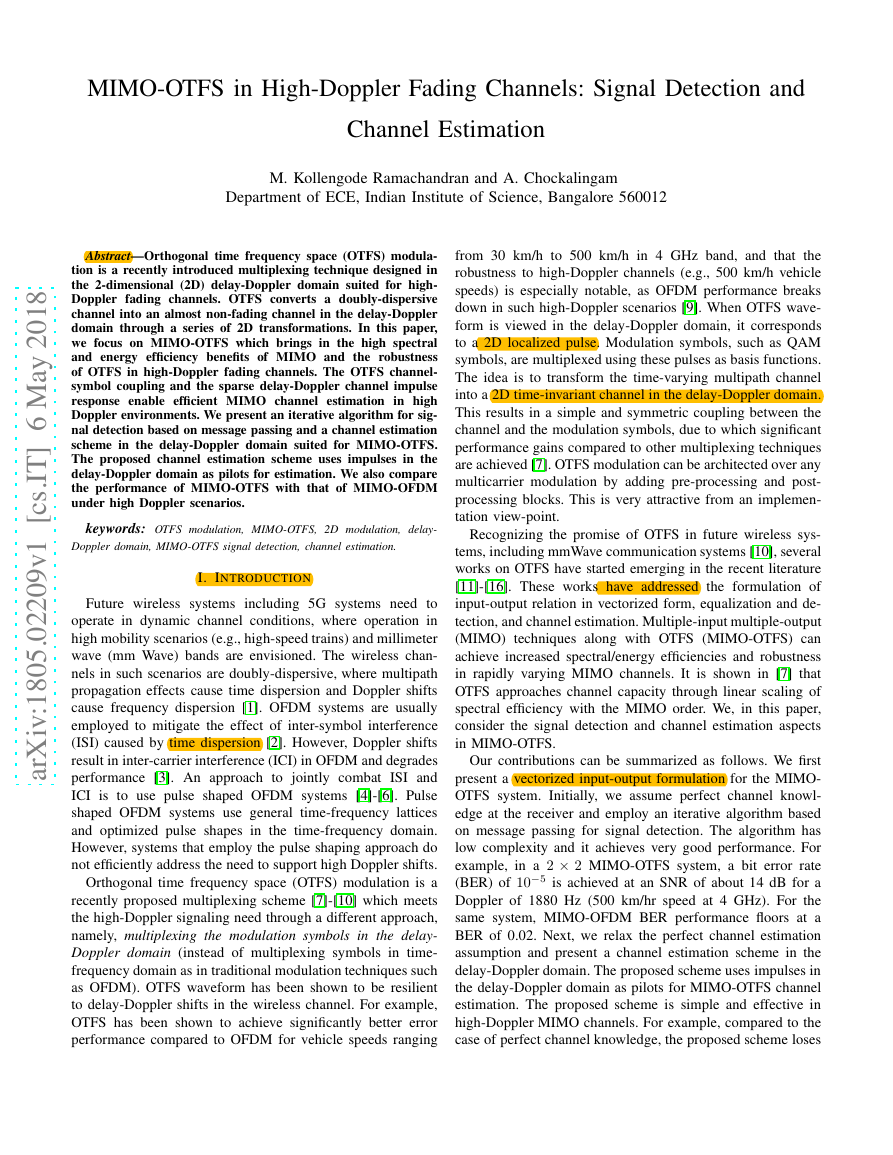

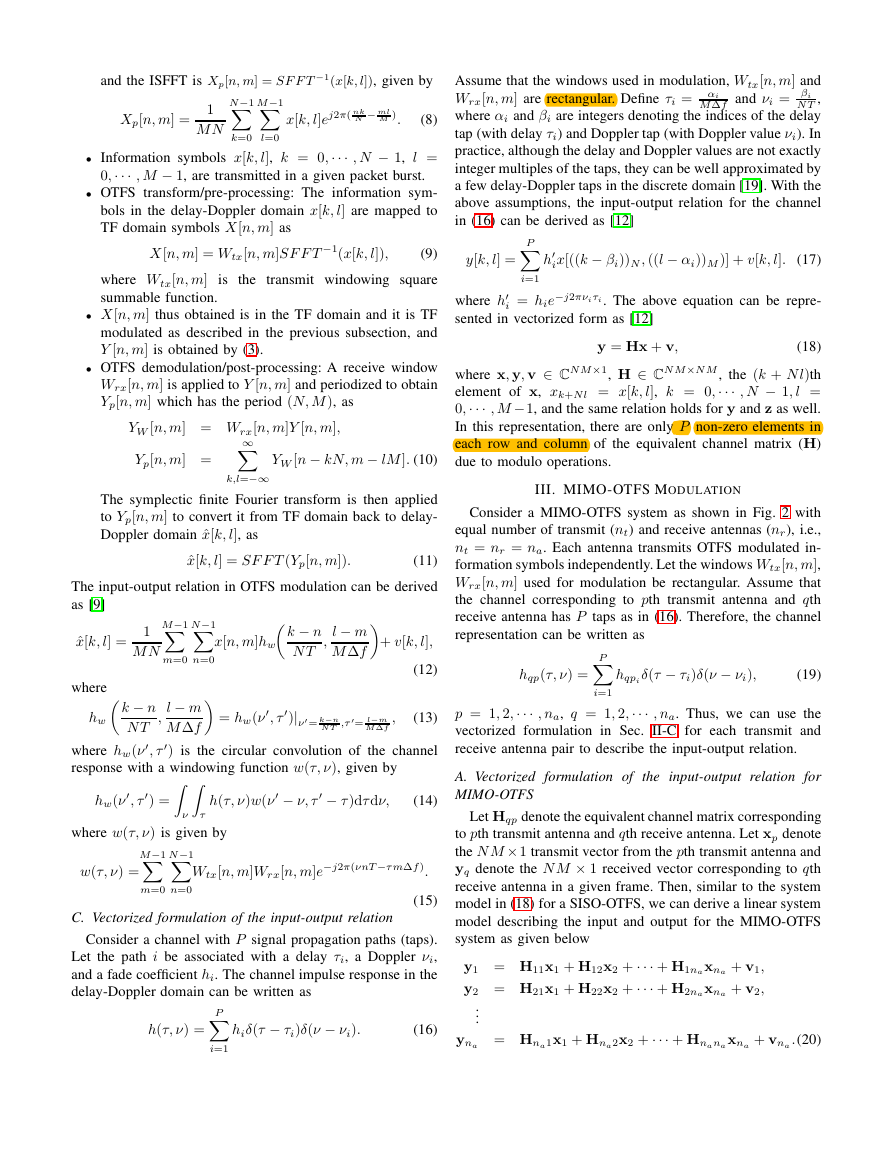
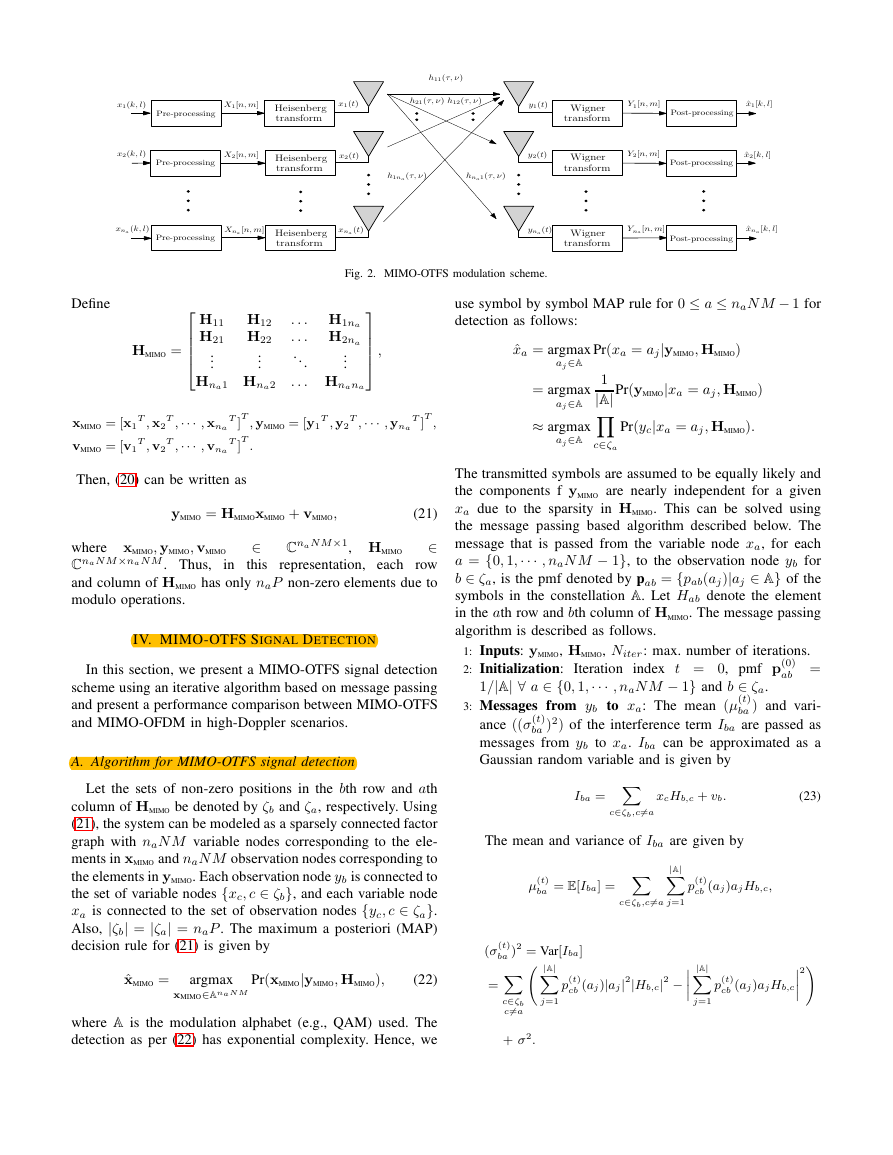
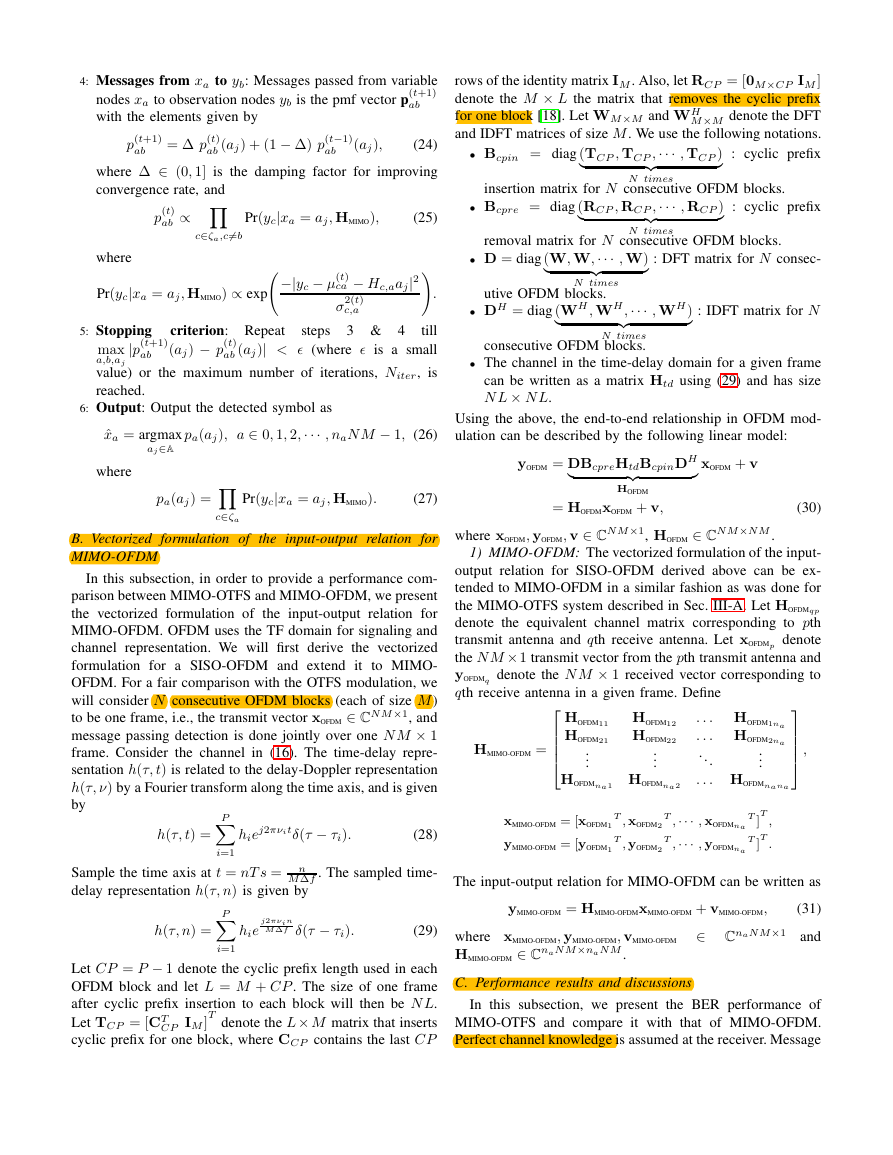

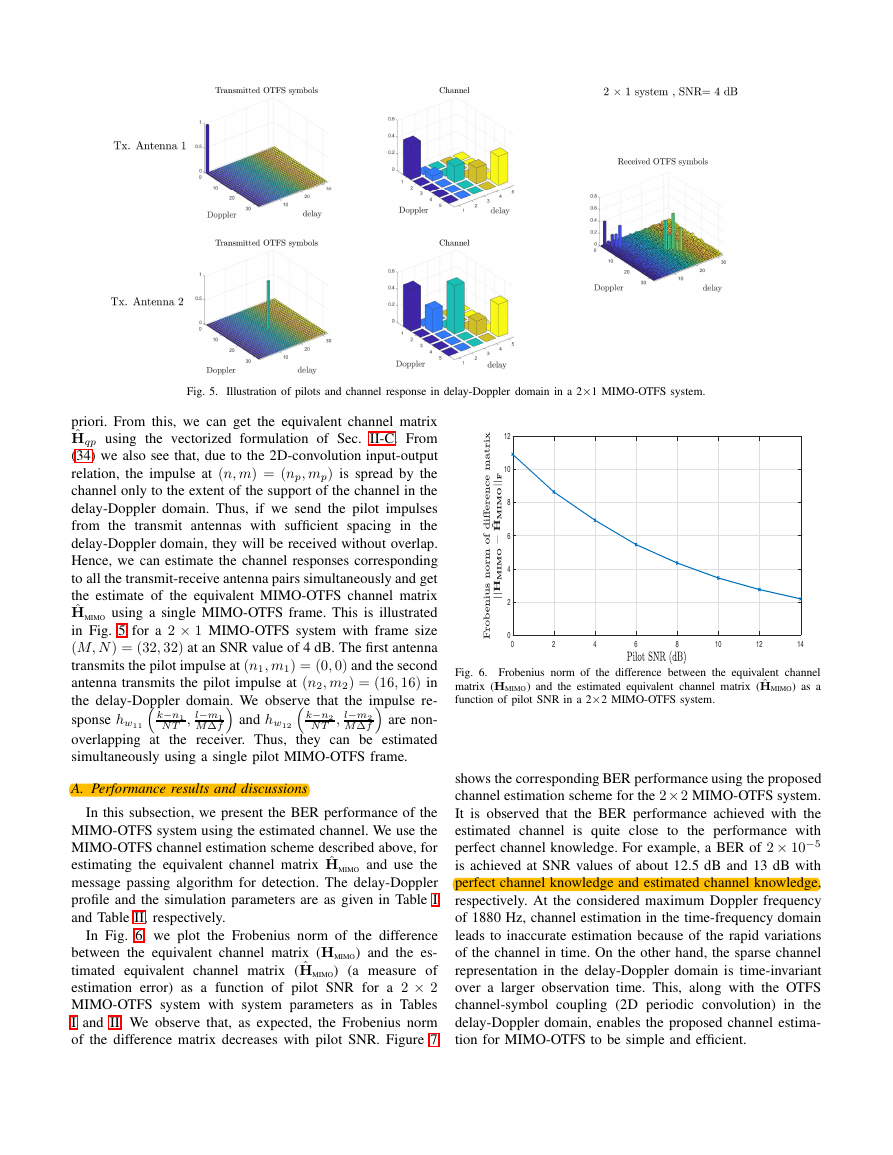
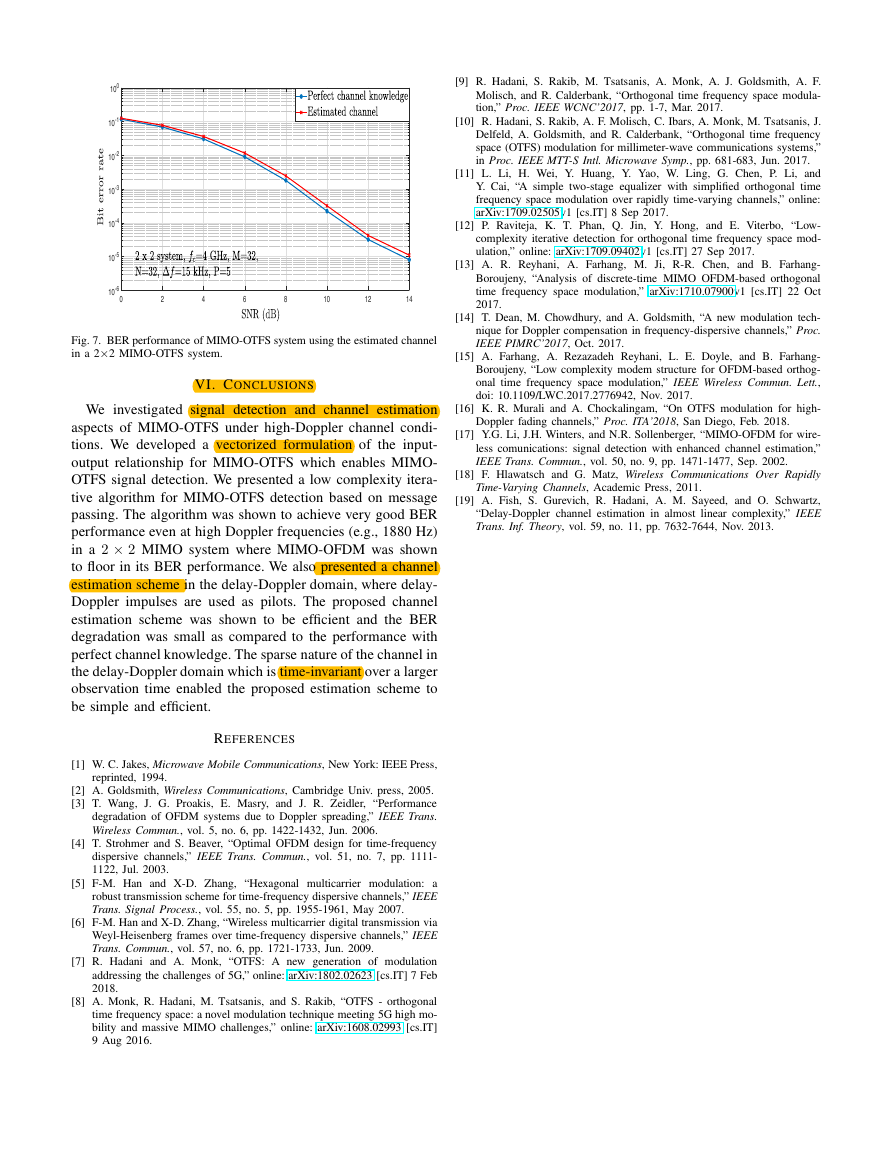








 2023年江西萍乡中考道德与法治真题及答案.doc
2023年江西萍乡中考道德与法治真题及答案.doc 2012年重庆南川中考生物真题及答案.doc
2012年重庆南川中考生物真题及答案.doc 2013年江西师范大学地理学综合及文艺理论基础考研真题.doc
2013年江西师范大学地理学综合及文艺理论基础考研真题.doc 2020年四川甘孜小升初语文真题及答案I卷.doc
2020年四川甘孜小升初语文真题及答案I卷.doc 2020年注册岩土工程师专业基础考试真题及答案.doc
2020年注册岩土工程师专业基础考试真题及答案.doc 2023-2024学年福建省厦门市九年级上学期数学月考试题及答案.doc
2023-2024学年福建省厦门市九年级上学期数学月考试题及答案.doc 2021-2022学年辽宁省沈阳市大东区九年级上学期语文期末试题及答案.doc
2021-2022学年辽宁省沈阳市大东区九年级上学期语文期末试题及答案.doc 2022-2023学年北京东城区初三第一学期物理期末试卷及答案.doc
2022-2023学年北京东城区初三第一学期物理期末试卷及答案.doc 2018上半年江西教师资格初中地理学科知识与教学能力真题及答案.doc
2018上半年江西教师资格初中地理学科知识与教学能力真题及答案.doc 2012年河北国家公务员申论考试真题及答案-省级.doc
2012年河北国家公务员申论考试真题及答案-省级.doc 2020-2021学年江苏省扬州市江都区邵樊片九年级上学期数学第一次质量检测试题及答案.doc
2020-2021学年江苏省扬州市江都区邵樊片九年级上学期数学第一次质量检测试题及答案.doc 2022下半年黑龙江教师资格证中学综合素质真题及答案.doc
2022下半年黑龙江教师资格证中学综合素质真题及答案.doc